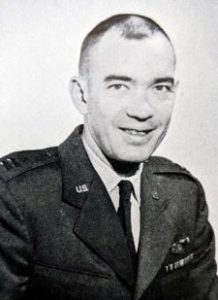 Capt Lawrence Thomas Holland was born on May 15, 1934, and hailed from Alhambra, California. He was assigned to the 615th Tactical Fighter Squadron out of DaNang.
Capt Lawrence Thomas Holland was born on May 15, 1934, and hailed from Alhambra, California. He was assigned to the 615th Tactical Fighter Squadron out of DaNang.
‘On 12 June 1965 Major Lawrence T. Holland was the pilot of an F100D Super Sabre conducting a tactical mission in Tay Ninh Province, South Vietnam. His aircraft was the lead in a flight of two. The mission flight path took them from DaNang to Ban Be Thuot, and then on to Dong Xoai Military Camp, which was located on the north side of Highway LTL13. The return leg of their flight was to take them back to Ban Me Thuot, and on to DaNang Airfield.
After arriving in the target area, Major Holland established radio contact with the Forward Air Controller (FAC) who was directing this strike mission. The FAC provided Lawrence Holland and his wingman with relevant current information about the location of VC forces, and then cleared both aircraft into the attack. After making several passes on positions located in double canopy jungle, Lawrence Holland transmitted that his aircraft had been hit by hostile fire, and shortly thereafter, he safely ejected.
Both the FAC and his wingman observed his parachute descend and land in 100-foot tall trees near the runway at Thuan Lo and the village of Bon Luan. The loss location was also just east of Highway LTL1A, 2 miles north of the junction of Highways LTL1A, LTL13 and 14; 26 miles southeast of Loc Ninh and 52 miles north-northeast of Saigon, Tay Ninh Province, South Vietnam.
A Thanh Loi Rubber Plantation bordered LTL1A to the west. Double canopy jungle dotted with small clearings, groves of bamboo, and laced with roads, trails, rivers, and streams of all sizes lay to the east of highway LTL1A. Small hamlets and villages were scattered throughout this hotly contested region.
Lawrence Holland’s wingman immediately called in a nearby search and rescue (SAR) helicopter that had been orbiting a short distance away. It landed in the nearest clearing and several members of the SAR aircrew proceeded on foot into the woods in search of the downed pilot. As the helicopter remained on the ground, it was fired upon by Viet Cong (VC) soldiers.
During the ensuing firefight that raged between VC and the Americans both on the ground and aboard the helicopter, SAR personnel observed enemy troops dragging the limp body of Major Holland into a nearby ditch. The helicopter’s crew was unable to reach Major Holland before the communists pulled him from view. Further, the Americans were unable to determine if he was dead or merely unconscious. With nothing else for them to do, the SAR personnel returned to the helicopter. As soon as they were on board, the aircraft lifted off and returned to base. At the time SAR efforts were terminated, Lawrence Holland was reported as Missing in Action.
On 30 August 1971 information was received by the US government that was sufficient to determine that Lawrence Holland died trying to escape his would-be captors. Reportedly, he was shot and killed and then buried in the immediate vicinity of his incident. No information or remains, however, have ever been turned over by the Vietnamese to support their report of his death.'(1)
The Air Force Cross was awarded posthumously to Major Holland.
Source: Together We Served, http://taskforceomegainc.org/h401.html
